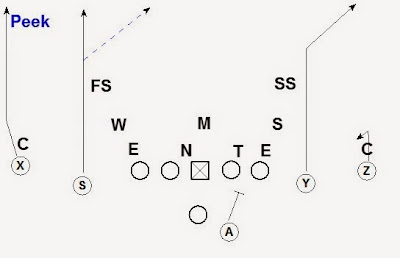I have always coached defense. However, I thought I would share a passing concept I would run if I ever end up
coaching on the other side of the ball. Even if that never happens, it does not
hurt to study what offenses are running. So here goes.
The route combination is a smash concept to the field with a
seam read and a vertical peel concept to the boundary.
The route progression for the QB is:
Peek the Vertical (X)
1. Field Corner (Y)
2. Seam Read (S)
3. Vertical Peel (X)
The Peek is a pre-snap read used vs. a press man look.
The
QB can throw the outside release vertical to the X as a 1 on 1 winner route. If
the QB likes the matchup he can take it, otherwise he follows his normal route
progression.
The first post-snap read is the field corner. If the corner
sits in the flat the QB will throw the corner route to the Y.
If the corner sinks the QB works to the S on the seam read
route. The S is running 2 yards outside the NCAA hash. As he runs vertical, he
is looking at the middle of field (MOF). If a safety is aligned in the MOF or
rotates to the middle, the MOF is closed.
When the MOF is closed the S stays in
the seam and should expect the ball thrown on a line as he clears linebacker
depth.
As the S is running the vertical and there is no safety in
the MOF, the MOF is open.
When the MOF is open the S breaks his vertical to a
post and should expect the ball in the middle of the field.
The 3rd route in the progression is the vertical
peel. The X runs an outside release vertical. If he gets press coverage he must
be ready for the ball on the peek throw from the QB. If there is no press, the
X is running vertical reading the coverage of the corner. If the X beats the
corner and gets on top, the X continues to run vertical. If the corner is over
the top of the X’s vertical route, the X will peel the vertical back to a
comeback route at 12-15 yards. The 3rd route in the progression is
thrown when the defense is running a hybrid coverage.
In this example a pattern
match cover 3. If the field corner
sinks, the QB works to the S on the seam read. If the S is being matched
vertical by a safety or linebacker the QB will work the X as the 3rd
read.
Switch:
The route can be tagged with a switch call to switch the route
of the X and S. The S now runs a wheel & peel while the X runs a seam read.
This tag is good against a safety getting width when #2 is out like Cover 2 and
2 read coverages. As the safety works for width to get over the top of #1, the
X is working to the seam and breaking to the post. The switch call can also be
good against man or matchup zone coverages. It can be difficult for the
defenders to navigate the traffic of the wheel and seam read as they cross.
Alert:
Another tag is an Alert for the hitch. This can be used in
on schedule situations (1st&10, 2nd Medium, 3rd
Medium/Short). The goal of an alert call is to throw the hitch. The alert tag
tells the QB he can throw the hitch is there is space.
The QB makes a pre-snap
read of the field side coverage. If the corner is soft and there is space to
throw the hitch the QB can throw the hitch. If throwing the hitch, the QB will
not take a 5 step drop and will instead throw with 3 step tempo and footwork.
If there is no space or if the QB is unsure, the QB will use the normal footwork
and route progression.
Against teams that disguise their coverages or rotate to
coverages at near the snap, I would run this route from a Polaroid tempo. I
call it Polaroid because the QB will let the picture develop. The offense will
line up and hard count. The offense does not look to the sideline following the
hard count. The hard count is used to let the offense see the defense. The QB
is looking at the coverage for a clear picture of safety rotation, bail
corners, etc. The seam read receiver can start to see the MOF picture as well.
Following the hard count the offense will immediately start the real snap count
and run the play. Polaroid tempo prevents the defense from changing the call after
the freeze. Polaroid is good for the base play or to allow the QB to see if the
alert hitch has space.









No comments:
Post a Comment